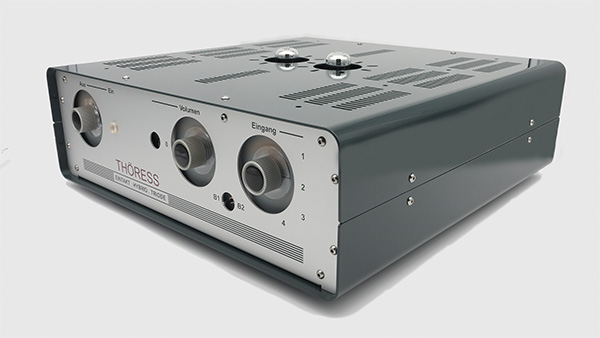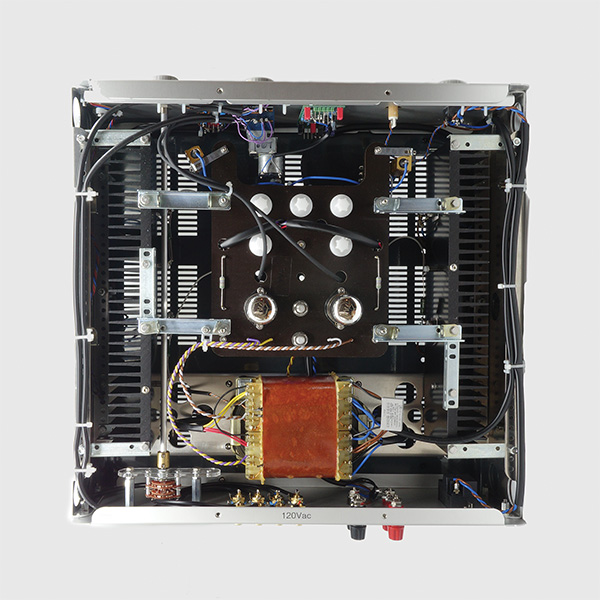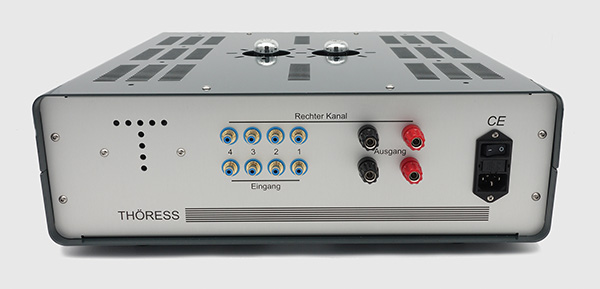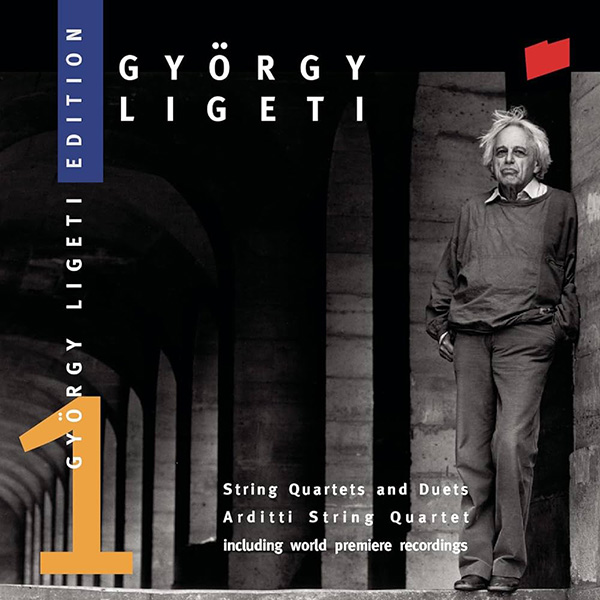| Columns Retired Columns & Blogs |
I'd like to point out that Iannis Xenakis was Greek, not French. He became French citizen later on his life. I highly recommend to check his life at Wikipedia, it may surprise you!

Last weekend, I visited an old friend who lives near Walden Pond of Henry Thoreau fame. I hadn't visited him since before the pandemic. He had just finished adding a wing to his house that included a dedicated hi-fi listening room the size and shape of a small church. Below a cathedral ceiling, the sweet spot featured seating for no fewer than 30 guests. Besides serving as his main listening room—he has another one that's smaller—it serves as a large residential parlor with a baby grand piano for use in chamber music performances, which feature prominently in his and his wife's social calendar.
It was a high-SPL thrill to experience his towering, field-coiled RCA theater horns (above) powered by RCA 845 amplifiers. We listened to highlights from his collection of master tapes played back on his 30ips Studer deck and to black discs played on one of his Fairchild 750 record players. The snacks were fine, and the people were all smiles, full of good stories and kind-heartedness.
I doubt many audiophiles have experienced a personal home sound system that moved this much air or pressurized a room this big. I kept thinking, "Man oh man, these enormous bass horns make regular woofers sound like emphysemic mice."
My friend's high-ceilinged space was perfectly sized and shaped for his giant speakers. That's because it was designed carefully by an acoustician and built for no other purpose than to show off his vintage horns at their best. That room was neither too dead nor too reverberant. The voices of people in conversation were unusually intelligible, even at some distance, even in a sea of sound with 110dB peaks.
On the way back to NYC, my BFF runnin' buddy, who was driving, laughed, saying, "Herb, do you think objectivist audiophiles host listening parties like this?" I snickered. "If they do, they don't invite me." Then, silently, my Herb-brain wondered what measurementphiles might notice about the sound if they were there today listening with us to horn speakers and tube amps made in the 1930s.
It was almost midnight. As we drove home in the rain, I relaxed with my feelings of renewed kinship with a group of friends I hadn't seen in years. I felt grateful for being included in this outlier cohort of DIYers, turntable geeks, R2R tape-heads, and big-horn aficionados.
For the record: As that Walden Pond system played music, guests (including me and a group of non-audiophile neighbors) applauded after every track.

Thöress EHT MKII integrated amplifier
Halfway through reading Robert Schryer's 2023 Montreal Audio Fest report—the one dated March 30 with the photo of those 1970 Rectilinear Highboy speakers—I slammed on my brain-brakes. Remembering Art Dudley's April 2015 review of Reinhard Thöress's fantastic, vertically oriented 300B amplifier, I Googled "Thöress" and began reading about the more conventional-looking amp Rob was describing: the $10,995 EHT MKII hybrid tube-MOSFET integrated. Within minutes, I had emailed company founder and chief engineer Reinhard Thöress and importer Erik Fortier (of Phonographe America, footnote 1) asking if I could borrow a review sample. I was cranked by how cool and unusual this amp looked in the photos and by Robert's description of its 20W-into-6-ohms, no-feedback topology.
The EHT integrated amplifier is made in Aachen, Germany. It comes with a palm-sized (2.5" × 5") plastic remote that says THöRESS in big red letters across the top, and Volumen in smaller black letters at the bottom. It has only two buttons: one labeled Leiser (quieter) and the other labeled Lauter (louder). That's it. No mute or input-selector buttons. It's the classiest-looking, funnest-to-use remote control I've ever seen. It doesn't need a Stumm (Mute) button because the EHT's motor-driven Alps potentiometer drops the volumen to silence in zwei sekunden.
At night, the Thöress EHT's asymmetrically arranged front panel showcased three backset, backlit, retro-looking plastic knobs and a power button—all haloed by soft, shadowy, lava-orange light. Protruding from the chassis top are two of the most highly revered voltage-amplifier tubes: octal-based 6J5 medium-mu triodes, each of which is essentially half of a 6SN7 dual triode. These tubes' dull emitters glow the same color orange as the front-panel control lights. The effect of this light is distinctly comforting.
During daytime, that orange light glows only faintly, but it nicely accents the industrial-gray German-tech coolness of the EHT's superbly finished aluminum casework, with its anodized printing and glossy, powder-coated chassis lid. To my old German gear-head eyes, the EHT's shapes, surfaces, and colors seem well-orchestrated to express the company's PR tagline:
THöRESS...A Tribute to Professional Audio Components from the Golden Age of the Electronic Tube!
I think the EHT is the coolest-looking integrated I've discovered, but when I asked my partner "bb" what she thought of Thöress's style, she declared it "Too masculine!" It's a good thing I never told her about my Lanz Bulldog tractor fetish.
I often joke that most audio equipment sounds like a combination of what it looks like and where it was made. Those two factors are usually inseparable, so I confess to beginning these auditions expecting the made-in-Germany Thöress EHT to sound like it looks.

Design
According to the Phonographe website, the EHT MKII amplifier "is based on a unique minimalist single-ended zero-feedback vacuum tube MOSFET hybrid topology which we call EHT Topology (E/intakt-H/ybrid-T/riode, single-ended hybrid triode)." That sounds like marketing-speak to me, but I believe that a single, voltage-amplifier triode driving an easy-to-drive, unity-gain, current-sinking MOSFET output buffer, operated in single-ended mode with "high idle current and low output impedance," is an elegant solution to the problem of how to drive a wide range of speakers with a low-powered, no-feedback amplifier.
Reinhard Thöress has written a paper, available on his website, that addresses the question of why single-ended topologies are superior to balanced circuits. The back panel of the EHT has four single-ended RCA inputs plus two pairs of high-quality speaker-wire binding posts. Fear of scratching the green-gray coat dissuaded me from removing the top cover, but according to the website, inside there's a C-core power transformer, a legion of high-quality German-made capacitors, and point-to-point wiring. Input impedance is specified at 100k ohms, output impedance at a mere 0.3 ohms—usefully low for a tubed amplifier. Voltage gain, with the volume control set to max, is 26dB. The EHT MKII measures 17" (434mm) × 17.7" (450mm) × 7.2" (184mm) and weighs 39.6lb (18kg).

Listening
I've used one or another BBC LS3/5a speakers since the late 1970s, so my ears are sensitized to how differently different amplifiers enable those little sealed-box two-ways to project musical energy into my room—so sensitized that I have come to believe that this energy projection (I also think of it as dynamic presence) is, along with rhythm-keeping, a key determinant of my system's engagement factor. It seems to be the main thing that makes recordings come alive in my room. With the EHT driving the Falcon LS3/5a's, at first all I noticed was smoothness, a deep spatial rendering, and a highly refined instrumental tone. That was before I played string quartets by my most beloved modern composer: György Ligeti (György Ligeti Edition, Vol.1, Arditti String Quartet 16/44.1 FLAC, Sony Classical/Tidal). I listened repeatedly to Ligeti's String Quartet No.1, Metamorphoses Nocturnes. Sometime during my third listen, I realized how much recorded energy the Thöress amp was projecting during Quartet No.1's extended silences. This wasn't noise, or distortion (those things are static and inert); this was live, morphing, three-dimensional energy—energy that's on the recording—floating tangibly between, around, and above my Falcon Gold Badges. What made this noteworthy was that I couldn't remember experiencing energy like this before. I could hear and feel this near-silence energy coming through even during a hot day with my windows open and a fan turning at low speed.

That silence-energy I noticed is likely a reverb-compression effect used on the recording, something the producers did to keep listeners from thinking their stereo switched off or reaching for the volume control. Whatever it was, it was much more noticeable with the Thöress integrated than it was with my homemade "hybrid separates," the tubed, Lab 12 Pre 1 preamp driving the Parasound Halo A 21+ amplifier.
Also interesting: The Hana Umami Blue moving coil cartridge's smooth, refined delivery was almost too much of a good thing combined with the EHT's smooth, refined sonics. Playing the 2009-remastered version of Astor Piazzolla's 1986 recording Tango: Zero Hour (Nonesuch/American Clavé Recordings LP 075597915297), an album I can't stop studying and enjoying, I was a bit let down by its politeness and lack of Argentinian bite. This recording needs to grab the listener by sounding edgy, tense, and intense, with bits of postmodern irony seeping through. Instead, it just sounded extremely nice.

I'd like to point out that Iannis Xenakis was Greek, not French. He became French citizen later on his life. I highly recommend to check his life at Wikipedia, it may surprise you!


Way back when my wife and I were dating Xenakis was one of the ones that I'd queue up and have her wondering if she made a mistake. I'd compound the problem by trying to explain some of the math. She'd just scrunch her face and go "why?" Sncne then I've given her better reasons to question her choice.

No overblown casework or indecipherable controls.

Off the shelf t save money? It looks like an old instrument case to me- probably deliberately

Love it!!! That album is possibly the pinnacle of the incredibly refined texture of tango that Piazzolla created.

... you might enjoy this recording:
https://www.steinway.com/music-and-artists/label/tango-nuevo-pablo-ziegler-john-o-riley

I am a sucker for Kossinskaja's transcription of Oblivion for guitar.

When I saw the picture I had hoped the whole article would be about that RCA theater horn system. Info about RCA, WE, and Altec systems on the internet seem to be mostly limited to discussion boards, so I’d love to read a proper article from you about them. At the most basic level: why three channels for audio that was only recorded in mono? How is the source > preamp > amp chain set up for a system like this? How many amps would have to be used? What happens when you use a solid state Crown amp to drive these instead of tubes? And so on.
I do have a music recommendation for you: you can find it on Tidal with the album title “Some Mississippi Sunday Morning” under the artist Parchman Farm Prayer, though the LP jacket suggests the latter is the title and the former is the subtitle. A live field recording of prisoners at Parchman Farm singing at their Sunday chapel, made by Ian Brennan (who has worked with Tinariwen). Sense of recorded space is off the charts. It’s like a contemporary Lomax recording. Transparent is probably the best description — you can feel the creaky floorboards, breath the Mississippi air, and feel the despair, longing, regret, and caged joy of every man singing.

a little bit deeper to "Some Mississippi Sunday Morning" while I am typing these words; you are right, it is deep and spacious! Beautiful sound.
For real horn info you'll have to venture beyond my limited knowledge. I recommend "High Quality Horn Loudspeaker Systems" by Bjørn Kolbrek and Thomas Dunker. Both authors are top-level wizards.
It covers everything and can be bought from Parts Express
good luck on your adventure
the system in the photo was operating with two speakers in stereo
herb

I would LOVE to listen to the Dead through that amazing system.
My friend has modified Klipsch K-Horns with bass bins and SET Monoblock's and what a beautiful system.
The cat with that system sure ate the canary.
Wicked cool system!!!

the host played an R2R tape made at a Dead concert
it forced revelers into quietude
h